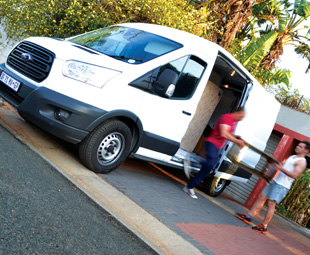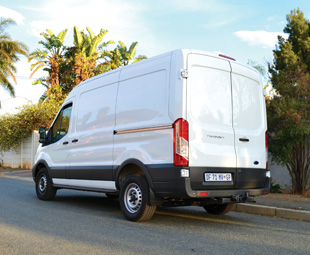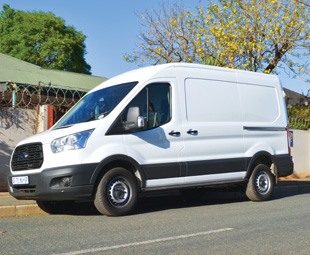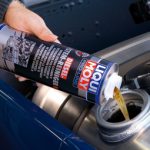Tail-waggingly good

The Ford Transit Custom is possibly the best medium-sized van you can buy, and the company wants a repeat performance from the full-sized version. GAVIN MYERS puts one to work and realises that it could be one of man’s best (load-carrying) friends.
There I was, sitting in afternoon traffic, laughing out loud behind the wheel of the new Transit. No, Joburg traffic hadn’t finally cracked me. I had realised that, front on, the Transit actually looks like a pug, or similar pup; what with its squashed up nose/grille, big googly eyes/headlamps and black mouth/plastic bumper. My mind immediately clicked to the “’84 Sheepdog” of Dumb & Dumber fame … and I didn’t stop giggling the whole way home.
Of course, there was an altogether more serious side to my driving the new Transit. You may have read our launch preview of Ford’s new range of panel vans and chassis cabs in the October issue of FOCUS … A little further into the magazine and you might also have read my review of the VW Transporter Crew Bus, which I was able to make use of while moving house. Well, the latter half of this year brought on a lot of moving for my family, as a few months after I made my move, it was my mother’s turn.
 Keen to prove what its new Transit can really do, Ford South Africa very kindly lent me a medium-wheelbase (MWB) medium-roof Panel Van version for the task. With a gross vehicle mass (GVM) rating of 3 300 kg, it only requires a general code 8/EB driving licence (payload weighs in at 1 325 kg, with a gross combination mass of 5 325 kg).
Keen to prove what its new Transit can really do, Ford South Africa very kindly lent me a medium-wheelbase (MWB) medium-roof Panel Van version for the task. With a gross vehicle mass (GVM) rating of 3 300 kg, it only requires a general code 8/EB driving licence (payload weighs in at 1 325 kg, with a gross combination mass of 5 325 kg).
While this may be the smaller of the two panel vans available, its load area is certainly commodious: at 3 044 mm in length, 1 784 mm maximum width (1 390 mm between the wheel arches) and 1 886 mm in height, over 9,1 m3 of volume – accessed through 270°-opening rear doors and a wide left-had side sliding door – swallowed up the household goods with consummate ease.
Not all at once, obviously … Numerous trips were made (one load was exclusively pot plants and garden ornaments – add a sun roof and it could’ve been a mobile greenhouse!) which gave the prefect opportunity for the 2,2-litre Duratorq engine to show off its fuel-sipping abilities.
Unfortunately, while Ford claims consumption of 7,6 l/100 km on the combined cycle, the onboard computer returned figures considerably higher at the end of our week of 14,3 l/100 km. Bear in mind, however, that this was made up purely of relatively short (up to 15 km) inner-city trips, so better figures should be achievable.
Nonetheless, Ford’s 2,2-litre diesel is a peach (we already knew this from the many kilometres spent with it in the Transit/Tourneo Custom and Ranger models). Producing 92 kW and 352 Nm in this front-wheel drive variant, the engine puts its power down quietly and smoothly (certain road surfaces might force through a hint of torque-steer) via a six-speed manual transmission.
A point to note is that gears four to six are all overdrive ratios, so more highway trips would have a positive effect on fuel consumption.
And driving the Transit is as easy as piloting a little hatchback … during the move week I drove it in peak-time traffic to work and back, to the shops, everywhere – and it was no headache at all.
 You can certainly believe the “Transit legend”; of it being a favourite among British thieves for its manoeuvrability and handling – even today, laden or not, it must still be one of the leaders in its class in terms of ride and handling.
You can certainly believe the “Transit legend”; of it being a favourite among British thieves for its manoeuvrability and handling – even today, laden or not, it must still be one of the leaders in its class in terms of ride and handling.
It is also because Ford has designed the Transit to make the task of driving easier. It benefits from a well-thought-out and executed, high-quality interior that includes numerous storage spaces, including under the passenger bench (although extra door pockets wouldn’t go amiss).
From the driver’s seat, the large side mirrors, with fantastic wide-angle mirrors, make blind spots non-existent. Our van was fitted with the optional reversing camera with front and rear parking sensors, which made manoeuvring child’s play.
Otherwise, Ford has endowed the Transit with a host of electronic driver aids as standard, including ESP Traction Control with failed boost support, Emergency Brake Warning, ABS anti-lock brakes with Electronic Brakeforce Distribution (EBD), EBA (Emergency Brake Assist), Hill Launch Assist and Roll-Over Mitigation.
To ease the drudge of working in a mobile office, Ford has equipped the Transit with a rather decent sound system that includes remote steering controls. It has USB and Bluetooth hands-free capability, allowing drivers to concentrate on driving. In the load compartment, ten tie-down hooks are provided.
Should you be looking to actually buy the Transit – for, perhaps, moving purposes – you will be pleased to know that the R399 900 purchase price includes a four-year/120 000 km comprehensive warranty, a five-year/unlimited kilometre corrosion warranty, and three-years of roadside assistance with unlimited kilometres. A service plan is offered as a dealer option and service intervals are 15 000 km.
At the end of our move week, I have to admit to developing a bit of a soft spot for the Transit. It oozes Ford’s corporate DNA inside and out (the design elements of which are certainly evident in that pug-like face). It’s no more intimidating to drive than one of the company’s family cars. It’s quite endearing: just like your favourite pooch.
Published by
Focus on Transport
focusmagsa




